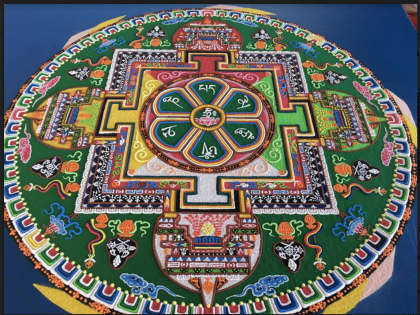Date/Time
Date(s) - 05/20/2018
12:15 pm - 1:45 pm
Remind me with
Location
Founders' Hall | UUFSD
Categories
Following the 9:00am and 11:00am Buddhist Meditation Worship Services, the monks will conduct the Dissolution Ceremony for the sand mandala. After the ceremony, there will be mingling with the monks over tea and cookies and a carpool to Cardiff State Beach to disperse the sand into the ocean, as a blessing for world peace. Everyone is welcome. (Paid parking in beach lot, free parking up the hill on the street.)
SACRED ARTS OF TIBET TOUR with The Monks of Gaden Shartse Norling Monastery
UUFSD is honored to host the monks of Gaden Shartse Norling Monastery, South India, during the week of May 16-20, for a Sacred Sand Mandala Creation. This ancient two dimensional Tibetan Buddhist mandala is the most artistic, labor-intensive and concentration-intensive of all mandalas created. For a full list of events, visit uufsd.org/sandmandala.
About Sand Mandalas

Mandala means literally “that which extracts the essence.” There are many different types of mandalas used by Tibetan Buddhists. They can be created in either two or three dimensions. The ones on the monks’ tour are two dimensional sand mandalas. These are without doubt the most creative, labor-intensive, and concentration-intensive of all mandalas created. The ones provided on the tour will require between 75 and 125 hours of effort, completed by several monks at a time.
Each sand mandala represents the architectural layout of the entire palace of a specific deity. The Manjushri mandala, symbolizes the embodiment of prajñā (transcendent wisdom). There are multi-layered symbolic images throughout the “palace,” where iconography, placement, and color all have significance.
In the past, sand mandalas were made with the powdered results of the grinding of precious stones, such as turquoise, lapis lazuli, coral, powdered gold and silver, and many other cherished and priceless materials. Today, this is only done on very special and/or auspicious occasions. More commonly, the colors are made of powdered and dyed stone, sand, dust, flowers, and charcoal. The colors are chosen to match the color of one of the Buddhas of the five Buddha families. The sand is applied very precisely by the gentle tapping of a sand-filled metal cone that has had its tip removed. The outline of the mandala is defined by the holding of a string that is dipped in chalk and then ‘snapped’ in the appropriate place.
Upon completion of the mandala, the monks will purposely destroy the magnificent work of art. The Buddha’s last words were “All things are impermanent, work out your salvation with diligence.” In upholding the principle that life is transient, the monks sweep up the mandala and place the sand in a river, lake, or ocean as an offering to purify the surrounding environment.

